Related Research Articles

The Hawker Hurricane is a British single-seat fighter aircraft of the 1930s–40s which was designed and predominantly built by Hawker Aircraft Ltd. for service with the Royal Air Force (RAF). It was overshadowed in the public consciousness by the Supermarine Spitfire during the Battle of Britain in 1940, but the Hurricane inflicted 60% of the losses sustained by the Luftwaffe in the campaign, and fought in all the major theatres of the Second World War.

No. 303 Squadron RAF, also known as the 303rd "Tadeusz Kościuszko Warsaw" Fighter Squadron, was one of two Polish squadrons that fought during the Battle of Britain along with No. 302 Squadron, of 16 total Polish squadrons during the Second World War. Flying Hawker Hurricanes, the squadron claimed the largest number of aircraft shot down of the 66 Allied fighter squadrons engaged in the Battle of Britain, even though it joined the fray two months after the battle had begun.
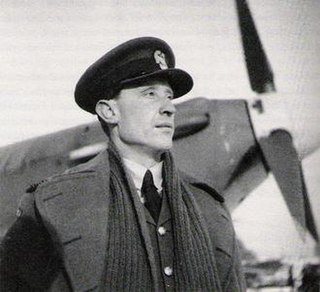
Witold Urbanowicz was a Polish fighter ace of the Second World War. According to the official record, Witold Urbanowicz was the second highest-scoring Polish fighter ace, with 17 confirmed wartime kills and 1 probable, not counting his pre-war victory. He was awarded with several decorations, among others the Virtuti Militari and British Distinguished Flying Cross. He also published several books of memoirs.

Mirosław Ferić, was a Polish-Croatian fighter pilot, a flying ace of World War II.

Witold Łokuciewski was a Polish fighter ace of the Polish Air Force in World War II who was given the nickname Tolo.

Marmaduke Thomas St John Pattle,, usually known as Pat Pattle, was a South African-born English Second World War fighter pilot and flying ace of the Royal Air Force (RAF).
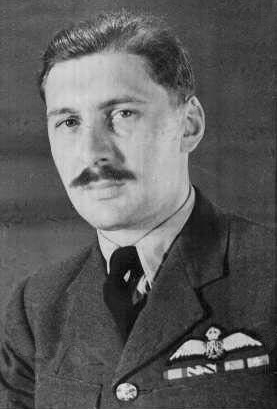
James Joseph "Orange" O'Meara, was a Royal Air Force officer and fighter pilot of the Second World War. He became a flying ace during the Battle of Britain while flying the Supermarine Spitfire, and by war's end was credited with 11 kills, two shared victories, one unconfirmed destroyed, four probables, 11 damaged and one shared damaged.

Wing Commander Robert Roland Stanford Tuck, was a British fighter pilot, flying ace and test pilot. Tuck joined the Royal Air Force (RAF) in 1935 and first engaged in combat during the Battle of France, over Dunkirk, claiming his first victories. In September 1940 he was promoted to squadron leader and commanded a Hawker Hurricane squadron. In 1941–1942, Tuck participated in fighter sweeps over northern France. On 28 January 1942, he was hit by anti-aircraft fire, was forced to land in France, and was taken prisoner. At the time of his capture, Tuck had claimed 29 enemy aircraft destroyed, two shared destroyed, six probably destroyed, six damaged and one shared damaged.

James Harry Lacey,, known as Ginger Lacey, was one of the top scoring Royal Air Force fighter pilots of the Second World War and was the second-highest scoring RAF fighter pilot of the Battle of Britain, behind Pilot Officer Eric Lock of No. 41 Squadron RAF. Lacey was credited with 28 enemy aircraft destroyed, five probables and nine damaged.
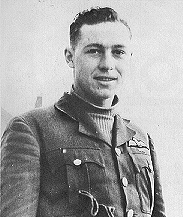
William Lidstone McKnight, was a Canadian aviator and flying ace of the Second World War. He was Canada's fifth-highest scoring ace of the war. McKnight joined the Royal Air Force (RAF) in early 1939 and served in No. 242 Squadron RAF during the final phase of the Battle of France, covering the Allied retreat from Brittany, and later the Battle of Britain.

Group Captain Billy Drake, was a British fighter pilot and air ace. He was credited officially with 18 enemy aircraft destroyed, two shared, two unconfirmed, four probables, two shared probables and five damaged and one shared damaged with the Royal Air Force during the Second World War. Further revisions to these statistics increased this total to 20 destroyed and seven damaged with a further 13 destroyed and four damaged on the ground.

Group Captain Charles Brian Fabris Kingcome was a British flying ace of the Second World War, most notable for serving with No. 92 Squadron in 1940 during the Battle of Britain. He frequently led the squadron on a temporary basis before receiving full command early in 1941.

Petrus Hendrik Hugo, was a South African fighter pilot and flying ace in the Royal Air Force (RAF) during the Second World War.
Richard John Cork, was a fighter ace in the Fleet Air Arm of the Royal Navy during the Second World War. Cork served in the Battle of Britain as the wingman for Douglas Bader of No. 242 Squadron RAF. When he returned to the Fleet Air Arm in 1941, Cork served with 880 Naval Air Squadron in the Arctic, Mediterranean and Indian Ocean. It was during Operation Pedestal in 1942 that he became the only Royal Navy pilot to shoot down five aircraft in one day, and was the leading naval ace using the Hawker Hurricane. He was given command of the 15th Naval Fighter Wing aboard HMS Victorious before being killed in a flying accident over Ceylon in 1944.
Francis Dawson-Paul was a fighter ace in the Fleet Air Arm of the Royal Navy during the Second World War. He was seconded to the Royal Air Force during the Battle of Britain, serving with No. 64 Squadron RAF. Between 1 and 25 July he shot down seven and a half German aircraft before being shot down himself over the English Channel. Taken prisoner by the crew of a German E-boat he died of his wounds five days later. In those 24 days of combat he became the first naval air ace of the battle and the highest scoring naval ace on the Supermarine Spitfire, a record which still stood by the end of the war.
Bolesław Andrzej Własnowolski, VM, KW, was a Polish fighter ace in the Second World War. He fought in the September Campaign and the Battle of Britain. Własnowolski is credited with four individual and one shared victories. He was killed when a German Messerschmitt Bf 109 aircraft shot down his Hawker Hurricane over southern England.

Albert Gerald Lewis, was a South African fighter pilot and fighter ace who scored an ace in a day during the Battle of Britain, later being featured in a Life magazine article about the Battle of Britain.
Helmut Mertens was a German fighter ace of World War II. He was born in Essen and served in the Luftwaffe as a career fighter pilot who served in the Battle of France, Battle of Britain, the invasion of Russia Operation Barbarossa and on the Western Front in the Defence of the Reich. His victory tally as a fighter pilot is reported as high as ninety-seven or as few as fifty-four aircraft confirmed shot down.
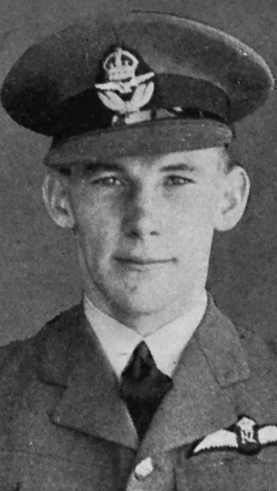
William Henry Hodgson was a New Zealand fighter pilot and flying ace who flew in the Royal Air Force (RAF) during the Second World War. He was officially credited with the destruction of five enemy aircraft.
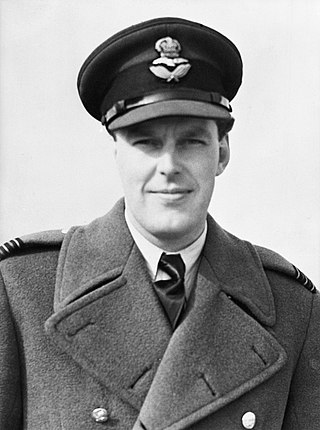
Michael Lister Robinson was a British flying ace of the Royal Air Force (RAF) during the Second World War. He is credited with shooting down at least sixteen aircraft.
References
- 1 2 3 Ketley, Barry (1999). French Aces of World War 2. Osprey Aircraft of the Aces. Osprey Publishing. ISBN 978-1-85532-898-3.